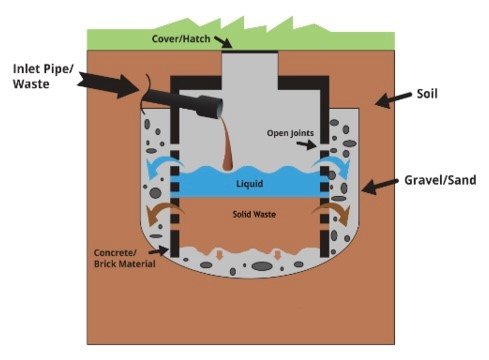What Is a Cesspool?
A cesspool is a type of sewage system. Essentially it is a large pit in the ground where all the waste and sewage go when you run water in the home or flush the toilet. These are very common in Hawaii due to the porous nature of the volcanic rock. Cesspools can be located anywhere in the yard and typically the cap is buried 1-3 feet below the surface. On average they are about 8-10 ft. in diameter and anywhere from 8-20 ft. deep.
How Do Cesspools Work?
The waste enters the cesspool and slowly percolates or seeps through the walls and into the ground. The function and health of the cesspool is reliant on the rocks or other masonry material lining the pit remaining porous. Disposing of grease and oil can clog the pores, which will not allow water to drain. This can cause overflow and failure.

Do Cesspools Require Maintenance?
The short answer is no. If you are conscientious about what you dispose of, there is typically no need for maintenance. If someone has mistreated the cesspool in the past this may have caused issues. Disposing of the wrong things over time may lead to low performance and failure.
Will I Ever Have To Convert My Cesspool?
As of 2017, cesspools are no longer permitted to be installed or repaired in Hawaii due to their negative impact on the environment. The State of Hawaii currently is requiring that all cesspools be converted to septic or sewer by 2050.
What Is A Septic Tank System?
The septic system is a small, on-site treatment and disposal system buried in the ground. the septic system has two essential parts: (1) the septic tank and (2) the soil absorption area.
How Do Septic Systems Work?
When household waste enters the septic tank, several things occur:
-
Organic solid material floats to the surface and forms a layer of what is commonly called “scum.” Bacteria in the septic tank biologically convert this material to liquid.
-
Inorganic or inert solid materials and the by-products of bacterial digestions sink to the bottom of the tank and form a layer commonly known as “sludge.”
-
Only clear water should exist between the scum and sludge layers. It is this clear water that should overflow into the drain field.

Do Septic Systems Require Maintenance?
Septic systems do require maintenance. The sludge that accumulates in the bottom of the tank must be pumped out periodically. Solids will continue to build up at the bottom of the tank, if it’s not pumped out, sludge will accumulate until it overflows where it can cause problems in the drain field. System maintenance also involves the bacteria necessary for solids digestion. If bacteria-killing products are used in the home, as they usually are, the bacteria should be replenished. If the bacteria level is too low, the solids may not be digested properly. The solids eventually build up and clog the system. The recommended pumping schedule is based on the number of people in the household and the size of your septic tank:



Leave your opinion here. Please be nice. Your Email address will be kept private, this form is secure and we never spam you.